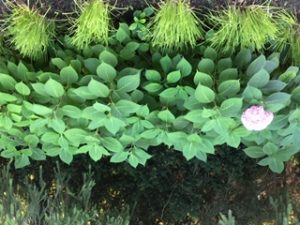
Hello my dear helper.
Location, Etobicoke sheltered spot, faces north west. These Hydrangea Macrophylla Nikko Blue are now ( 8 yrs ) a good 5 feet tall. They are too big for the location as they are hiding 4 Rhodos behind them.
My Problem. I know they are not to be trimmed if you want blooms next year. I leave them up all winter and very late into the spring. Is it possible to trim them down this fall to 2 feet snd still get flowers next summer. Except for the one bloom in the photo, these shrubs have not flowered in the last 3 years. They get multi purpose fertiliser and composted pine mulch every year. I have not been wrapping them for the winter but perhaps that would help get more blooms. If the only way to get blooms next year is to leave them as is, then I guess I will have to move the Rhodos. What do you think?
Thank you for your help
Thank you for contacting the Toronto Master Gardeners with your query.
A previous post on this web site answered a similar question to yours:
The nickname mopheads (H. macrophylla) is descriptive of the shape of their blooms. Blue, pink and purple are the most common colours. White is fairly uncommon. If the blooms on your hydrangeas are white, consider the possibility that they are not macrophyllas but are one of the other species.
Mophead hydrangeas do not have to be pruned back unless they are very old. Removing dead stems and blooms is the only pruning that should be done for the health of the plant, and these can be removed at any time. But if your hydrangea is getting much too large or old, use the following method.
These hydrangeas bloom on old wood. (Stems that have been on the hydrangea since the summer before the current season.) They produce flower buds in August, September or October for the following summer’s blooms. If those stems are pruned in the fall, winter, or spring, the bloom buds will be removed, and there may be little or no bloom the following summer (usually June/July for the northern hemisphere).
Unfortunately H. macrophylla is the variety most susceptible to winter bud injury in Southern Ontario. Our winters can be severe, so you might need to offer it some winter protection from severe winds to protect the flower buds. Tying the branches together and wrapping them with burlap isn’t pretty, but it could mean winter survival. Remove the burlap when the buds begin to swell.
If, instead of pruning your hydrangeas, you decide to move your Rhododendrons, we recommend that you review the American Rhodendron Society’s web site for information about transplanting them successfully. Here is a link to the website:
https://www.rhododendron.org/transplant.htm
Good luck.

